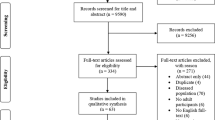Abstract
This cross-sectional study investigated bone mass in female athletes participating in an impact-loading sport (soccer), and evaluated whether any changes in bone mass could be related to the type of weight-bearing loading and muscle strength. The group of soccer players consisted of 16 second-division female players (age 20.9±2.2 years) training for about 6 hours/week. The reference group consisted of 13 nonactive females (age 25.0±2.4 years) not participating in any kind of regular or organized sport activity. The groups were matched according to weight and height. Areal bone mineral density (BMD) was measured in total body, head, lumbar spine, femoral neck, Ward's triangle, trochanter, the whole femur and humerus, and in specific sites in femur diaphysis, distal femur, proximal tibia, and tibia diaphysis using dual X-ray absorptiometry. Isokinetic concentric peak torque of the quadriceps and hamstring muscles was measured using an isokinetic dynamometer. The soccer players had significantly (P<0.05-0.01) higher BMD in the lumbar spine (10.7%), femoral neck (13.7%), Ward's triangle (19.6%), nondominant femur and humerus (8.2 and 8.0%, respectively), distal femur (12.6%), and proximal tibia (12.0%) compared with the nonactive women. There was no significant difference in muscle strength of the thigh between the two groups. In the nonactive group, muscle strength in the quadriceps and especially hamstrings, was correlated to BMD of the adjacent bones (whole femur, hip sites) and also to distant sites (humerus). In the soccer group, there were no correlations between muscle strength and BMD of the adjacent and distant bones. Soccer playing and training appears to have a beneficial effect on bone mass in young females, and it seems that there is a site-specific skeletal response to the type of loading subjected to each BMD site. Muscle strength in the thigh is not related to bone mass in female soccer players.
Similar content being viewed by others
References
Dalen N, Olsson KE (1974) Bone mineral content and physical activity. Acta Orthop Scand 45:170–174
Nilsson BE, Westlin NE (1971) Bone density in athletes. Clin Orthop 77:179–182
Fehling PC, Alekel L, Clasey J, Rector A, Stillman RJ (1995) A comparison of bone mineral densities among female athletes in impact loading and active loading sports. Bone 17: 205–210
Heinonen A, Oja P, Kannus P, Sievänen H, Mänttäri A, Vuori I (1993) Bone mineral density of females in different sports. Bone Miner 23:1–14
Heinonen A, Oja P, Kannus P, Sievänen H, Mänttäri A, Vuori I (1995) Bone mineral density in female athletes representing sports with different loading characteristics of the skeleton. Bone 17:197–203
Taaffe DR, Snow-Harter C, Connolly DA, Robinson TL, Brown MD, Marcus R (1995) Differential effects of swimming versus weight-bearing activity on bone mineral status of cumenorrheic athletes. J Bone Miner Res 10:586–593
Jones HH, Priest J, Hayes W, Tichenor CC, Nagel D (1977) Humeral hypertrophy in response to exercise. J Bone Joint Surg (59-A):204–208
Haapasalo H, Kannus P, Sievänen H, Heinonen A, Oja P, Vuori I (1994) Long-term unilateral loading and bone mineral density and content in female squash players. Calcif Tissue Int 54:249–255
Risser WL, Lee EJ, Leblanc A, Poindexter H, Risser J, Schneider V (1990) Bone density in eumenorrheic female college athletes. Med Sci Sports Exerc 22:570–574
Frost HM (1987) Bone “mass” and the “mechanostat”: a proposal. Anat Rec 219:1–9
Lanyon LE (1984) Functional strain as a determinant for bone remodelling. Calcif Tissue Int 36:56–61
Lanyon LE (1987) Functional strain in bone tissue as an objective, and controlling stimulus for adaptive bone remodelling. J Biomechanics 20:1083–1093
Lanyon LE (1992) Control of bone architecture by functional load bearing. J Bone Miner Res 7:369–375
Forwood MR, Burr DB (1993) Physical activity and bone mass: exercises in futility? Bone Miner 21:89–112
Lee EJ, Long KA, Risser WL, Poindexter HBW, Gibbons WE, Goldzieher J (1995) Variations in bone status of contralateral and regional sites in young athletic women. Med Sci Sports Exerc 1354–1361
Grimmston SK, Willows ND, Hanley DA (1993) Mechanical loading regimen and its relationship to bone mineral density in children. Med Sci Sports Exerc 25:1203–1210
Hyakutake S, Goto S, Yamagata M, Moriya H (1994) Relationship between bone mineral density of the proximal femur and lumbar spine and quadriceps and hamstrings torque in healthy Japanese subjects. Calcif Tissue Int 55:223–229
Rintek Madsen O, Schaadt O, Bliddal H, Egsmose C, Sylvest J (1993) Relationship between quadriceps strength and bone mineral density of the proximal tibia and distal forearm in women. J Bone Miner Res 8:1439–1444
Snow-Harter C, Bouxsein M, Lewis B, Charette S, Weinstein P, Marcus R (1990) Muscle strength as a predictor of bone mineral density in young women. J Bone Miner Res 5:589–595
Orwoll ES, Oviatt SK, Biddle JA (1993) Precision of dualenergy x-ray absorptiometry: development of quality control rules and their application in longitudinal studies. J Bone Miner Res 8:693–699
Sievänen H, Oja P, Vuori I (1992) Precision of dual-energy x-ray absorptiometry in determining bone mineral content of various skeletal sites. J Nucl Med 33:1137–1142
Nordström P, Nordström G, Thorsen K, Lorentzon R (1995) Local bone mineral density, muscle strength and exercise in adolescent boys. Calcif Tissue Int (in press)
Suominen H (1993) Bone mineral density and long-term exercise. Sports Med 16:316–330
Nigg B (1988) The olympic book of sports medicine. 1:363–373
Karlsson MK, Hasserius R, Nilsson JÅ, Obrant JO (1995) Bone mass and density of the head. Eur J Exp Musculoskel Res (in press)
Teegarden D, Proulx WR, Martin BR, Zhao J, Mccabe GP, Lyle RM, Peacock M, Slemenda C, Johnston CC, Weaver CM (1995) Peak bone mass in young women. J Bone Miner Res 10:711–715
Kannus P, Haapasalo H, Sankelo M, Sievänen H, Pasanen M, Heinonen A, Oja P, Vuori I (1995) Effect of starting age of physical activity on bone mass in the dominant arm of tennis and squash players. Ann Intern Med 123:27–31
Author information
Authors and Affiliations
Rights and permissions
About this article
Cite this article
Alfredson, H., Nordström, P. & Lorentzon, R. Total and regional bone mass in female soccer players. Calcif Tissue Int 59, 438–442 (1996). https://doi.org/10.1007/BF00369207
Received:
Accepted:
Issue Date:
DOI: https://doi.org/10.1007/BF00369207




